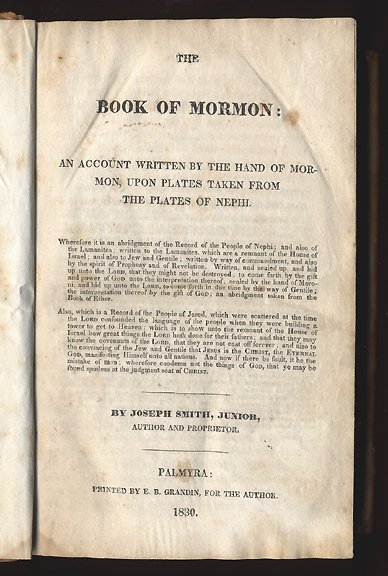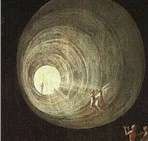 A first-edition Book of Mormon recently sold for $105,000 at auction ( NYT ). What better time to revisit the question of how the Book of Mormon was said to have been translated, and whether the story makes sense in light of what we know 180 years later.
A first-edition Book of Mormon recently sold for $105,000 at auction ( NYT ). What better time to revisit the question of how the Book of Mormon was said to have been translated, and whether the story makes sense in light of what we know 180 years later.
In Mormon 9:31-34, we find:
And now behold, we have written this record according to our knowledge in the characters, which are called among us the reformed Egyptian, being handed down and altered by us, according to our manner of speech. And if our plates had been sufficiently large, we should have written in the Hebrew; but the Hebrew hath been altered by us also; and if we could have written in the Hebrew, behold, ye would have had none imperfection in our record.
Reformed Egyptian was apparently a form of hieroglyphics. Let’s assume that somehow this language was indeed learned, preserved, and passed down among the Nephites and their descendants. What’s interesting is the next assertion—that records were kept in hieroglyphics because it was more compact . It’s a natural assumption for a linguistic newbie like Joseph Smith to make: those Egyptians can write whole concepts in single characters! What better way to save on page space!
Information theory teaches us otherwise. The number of bits of information in a message is roughly equivalent whether expressed in English or Chinese. The space occupied by the encoding is also roughly the same. Modern-day translators between Japanese and English know that the “byte count” of a Japanese original and English translation are almost exactly the same (where a Sino-Japanese character is counted as two bytes, and does in fact occupy approximately twice as much space on the page as an English letter, counted as one byte).
The alleged space savings from ideographic or hieroglyphic writing systems are also fatally compromised by the need to use them phonetically to spell out names and words for which no character has been defined. For instance, there was certainly no hieroglyphic in “reformed Egyptian” for “Nephi”, so we can assume it was written using at least two full hieroglyphic characters for their phonetic value—with the same holding for the vast array of proper names found in the Book of Mormon.
In other words, the assertion that hieroglyphics save space, as made in the Book of Mormon, clearly identifies the writer as someone who had probably never encountered any foreign language whatsoever, much less one written in an ideographic system.
The second implication in the passage quoted above—that if there had been enough space to write in Hebrew then the record would have contained no imperfections—is also puzzling. Is the point that reformed Egyptian is inherently less precise or more vulnerable to error, something modern linguistics would refute? Or that the writers and abridgers of the BOM didn’t know reformed Egyptian as well as they knew Hebrew, which also seems unlikely, if this language had been how records were kept across generations? Most likely, what we have here is another incorrect assumption by someone who knew nothing about languages or writing systems: that hieroglyphic systems by their very nature must be less precise and prone to error than “real” writing systems which use letters and words.
Let’s now turn to the actual process of translation. David Whitmer, one of the Three Witnesses, decribed it as follows:
Joseph Smith would put the seer stone into a hat, and put his face in the hat, drawing it closely around his face to exclude the light; and in the darkness the spiritual light would shine. A piece of something resembling parchment would appear, and on that appeared the writing. One character at a time would appear, and under it was the interpretation in English.
The fundamental misunderstanding of how hieroglyphic languages work is once again apparent. Assuming the semantic value of a hieroglyphic is approximately the same as that of a Chinese character, the sequence of “interpretations” of the individual characters might be something like the following for the first sentence in the Book of Mormon which starts “I, Nephi:”
I Nephi good parents born from, reason father knowledge received somewhat, also many day path along suffering seeing…
Joseph Smith could not possibly have gotten from this to fluent English, at least not without an intricate knowledge of Egyptian grammar. On the other hand, if God had actually presented him with fully-formed English sentences to be read off directly from within the hat like a teleprompter, there is no way this could be consistent with the description of one character being presented at a time.
Joseph Smith’s mistaken notion of hieroglyphics now becomes somewhat clearer. He apparently assumed that each character encapsulated not a single sememe or concept, but an entire phrase, such as “having been born of goodly parent”. Even if that were possible, the order of the phrases in the original would still not have been the same as in English, requiring a re-ordering process unaccounted for in the description above.
Martin Harris, another of the three witnesses, is reported to have described a much different translation process, as quoted by George Reynolds from a letter written to the Deseret News by Edward Stevenson, in “Myth of the Manuscript Found”, Juvenile Instructor Office, 1883 edition, page 91:
Martin explained the translation as follows: By aid of the seer stone, sentences would appear and were read by the prophet and written by Martin, and when finished he would say, “Written,” and if correctly written, that sentence would disappear and another appear in its place, but if not written correctly it remained until corrected, so that the translation was just as it was engraven on the plates, precisely in the language then used.’
Whether it was characters appearing one-by-one in the hat with the English “interpretation” below, or fully-formed sentences, one is puzzled by what the role of the actual plates was in this whole process—were they sitting on a table in the corner of the room? Were they ever actually consulted? If God could place the characters or sentences in the hat, like some early 19th century PowerPoint presentation, why was it even necessary to give Joseph the physical plates and then whisk them away later? For that matter, why was it even necessary to go through the laborious character-by-character process followed by transcription, when God could have simply written out the translation in longhand Himself on a pad of paper, or even just delivered the completed English manuscript?
There are yet other accounts of exactly how the hat and stone worked. Orson Hyde, an early apostle, claimed that:
These two stones, called Urim and Thummim, in diameter the size of an English crown (coin) only a little thicker, were placed where all light was excluded. The persons using these offered their prayers to the Lord, and the answer became visible, written in letters of light on the Urim and Thummim, but disappeared again soon after.
This gets trickier and trickier. The amount of text that could be written on a coin 50mm (.2”) in diameter, even in the smallest type, would be between one and two words, sort of like a Magic Eight Ball. Joseph Smith would have to have read these words off the coin quickly before they disappeared. Did the Urim and Thummim have a “Back” button in case he missed one?
Joseph Fielding Smith, later the sixth president of the church, was recorded by Oliver B. Huntington in his journal as having confirmed at a 1881 stake conference that the entire translation was letter-perfect:
Joseph did not render the writing on the gold plates into the English language in his own style of language as many people believe, but every word and every letter was given to him by the gift and power of God. So it is the work of God and not of Joseph Smith, and it was done in this way…The Lord caused each word spelled as it is in the book to appear on the stones in short sentences or words, and when Joseph had uttered the sentence or word before him and the scribe had written it properly, that sentence would disappear and another appear. And if there was a word wrongly written or even a letter incorrect the writing on the stones would remain there. Then Joseph would require the scribe to spell the reading of the last spoken and thus find the mistake and when corrected the sentence would disappear as usual.
We again see the confusion between characters, words, short sentences, and long sentences. If they were “short sentences”, how did these combine into the longer sentences in the actual translated work? If they were sentences, even short ones, how could they have fit on stones the size of the Urim and Thummin?
The position of the church, or of its leaders, underwent a 180 degree change when it became apparent that the BOM contained many simple spelling and grammatical errors of exactly the sort that an uneducated man such as Joseph Smith might have made. BH Roberts, the Mormon historian, stated:
It is impossible that the alleged translation, whether by divine or human media, could be a word-for-word bringing over from the Nephite language into the English…If the Book of Mormon is a real translation instead of a word-for-word bringing over from one language into another, and it is insisted that the divine instrument, Urim and Thummim, did all, and the prophet nothing—at least nothing more than to read off the translation made by Urim and Thummim—then the divine instrument is responsible for such errors in grammar and diction as did occur. But this is to assign responsibility for errors in language to a divine instrumentality, which amounts to assigning such error to God. But that is unthinkable, not to say blasphemous…that old theory cannot be successfully maintained; that is, the Urim and Thummim did the translating, the Prophet, nothing beyond repeating what he saw reflected in that instrument; that God directly or indirectly is responsible for the verbal and grammatical errors of translation. To advance such a theory before intelligent and educated people is to unnecessarily invite ridicule, and make of those who advocate it candidates for contempt …
It certainly does. But that is precisely the theory put forth by the earlier church fathers, which Roberts lamely blames on the fact that “our fathers and our people in the past and now were and are uncritical.” But this is not a matter of being uncritical or not. Those “theories” were explicit statements of how the translation process worked by people who were there at the time, and later prophet seers and revelators.
The conclusion is inescapable: the entire description of how the Book of Mormon was translated reveals nothing more or less than the utter linguistic ignorance of those giving the descriptions, and the linguistic gullibility of those believing them.

 A first-edition Book of Mormon recently sold for $105,000 at auction (
A first-edition Book of Mormon recently sold for $105,000 at auction ( Amidst the ongoing shrieking of atheist banshees, it’s a relief to see Sam Harris address the question of the human search for happiness in a
Amidst the ongoing shrieking of atheist banshees, it’s a relief to see Sam Harris address the question of the human search for happiness in a  Time magazine has published a cover story entitled
Time magazine has published a cover story entitled  Zen master Gudo Nishijima (pictured) believes in a world government run by the US military (
Zen master Gudo Nishijima (pictured) believes in a world government run by the US military ( Researchers have built a computer model which replicates our human ability to learn rules and use them to control ourselves—which scientists call “cognitive control”. Cognitive control is how we mold and channel our thoughts and actions to reach some goal. The prefrontal cortext (PFC) is a key player in cognitive control.
Researchers have built a computer model which replicates our human ability to learn rules and use them to control ourselves—which scientists call “cognitive control”. Cognitive control is how we mold and channel our thoughts and actions to reach some goal. The prefrontal cortext (PFC) is a key player in cognitive control. Students of neurotheology study
Students of neurotheology study  Are you studying to be a neurotheologian, but worried about your future career prospects? Now you may be able to find high-paid work as a commentator on sports figures’ religious experiences!
Are you studying to be a neurotheologian, but worried about your future career prospects? Now you may be able to find high-paid work as a commentator on sports figures’ religious experiences!